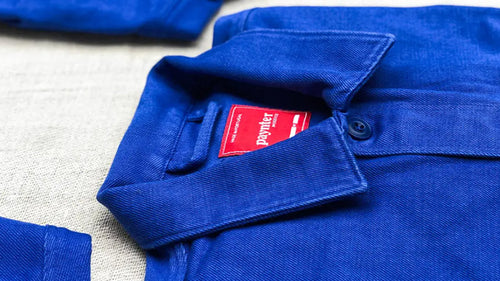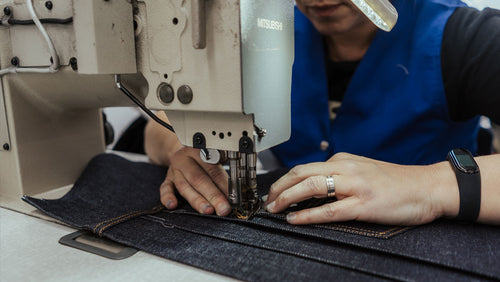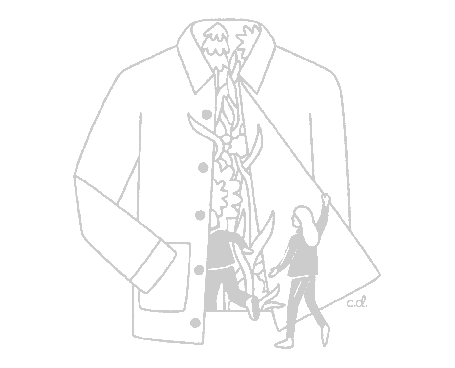Few types of clothing have impacted the modern wardrobe quite like military uniforms. Ever since the 1950s, garments introduced by the American and British armed forces have been a staple for civilian dress and have provided a constant source of inspiration for subcultures, social movements, and fashion designers alike. Items like chinos, bomber jackets, aviator sunglasses, and even cardigans are so omnipresent throughout society that it's easy to overlook the history and original intended use behind them. But as fashion journalist and author of Military Style Invades Fashion, Timothy Godbold states, “once you begin to notice the extent to which military styles have influenced fashion, it's impossible to ignore it.”
Trench coats: Martin Parr's photo taken in 1984 in the North of England capturing scenes outside the football.
Militaria is unmistakable and it is everywhere: worn by men, women and children across the globe. From streetwear to thrift-store chic, military appropriations are ubiquitous. You only have to look at BAPE's signature camouflage or Raf Simons coveted FW03 parka jackets to see how brands from all ends of the scale have long borrowed elements of utilitarianism from the style sheet of military uniform.
The Robert De Niro Taxi Driver jacket appropriated for the runway.
What makes these wartime staples so enduring is that they are based on practicality and uniformity. From cargo pants to combat boots, every item that a soldier wears is designed with a thought-out function to serve a purpose. And where is form more important to function, if not in life-or-death situations? Of course, by the time a design hits the runway or showroom floor, the original function has been all but forgotten. But by adopting elements of military style, designers can often imbue their garments with the considerable bravery, authority and timeless style still associated with military personnel. The word ''panache,'' after all, derives from the plume on a military helmet.
The British, of course, have always had exquisitely tailored uniforms. Items like the intricately tailored redcoats of the Revolutionary War might’ve had a brief renaissance among indie kids in Camden by the way of The Libertine’s, but it's Burberry’s infamous trench coats that have stood the test of time. There is historical debate over Burberry’s invention of the trench coat which was supplied to British soldiers during World War I. Aquascutum offered a similar style nearly half a century earlier for soldiers in the Crimean War using its patented waterproof wool. But what is certain is that Thomas Burberry invented the water-repellent gabardine fabric traditionally used to make the long, double-breasted coat with large lapels. In the post-World War II years, the style became equally popular with women and has since become entrenched as a symbol of British heritage style. Today it remains the pinnacle of the Burberry brand and is constantly revisited and reworked season on season by the designers at the house.

The beginnings of Burberry's Iconic Trench Coat
One of our favourite shots by Elliott Erwitt featuring the famous trench coat in 1989

The old Burberry factory
Another military design synonymous with British style is Dr. Martens leather ankle boots. Today, the brand's famous 1460 8-eyelet boots are remembered as uniform for youth culture groups like the skinheads and punks through to Pacific NorthWest grunge bands of the 90s. But the history of the boots dates all the way back to World War II. The story goes that the original founder Klaus Märtens, who was a doctor in the German army, injured his ankle while skiing in the Bavarian Alps during leave in 1945. Fearing that he’d be unable to return to service, Martens created a new boot that was more supportive than his military-issued pair. His design became so popular that Martens began exploring with different leathers and ankle heights as well as the signature air-cushioned soles to bring us the design that still survives today.
Punks wearing Dr Martens in 1983 Britain.
Like most non-traditional civilian fashion, like workwear, military style has found its way into the popular consciousness through various youth culture movements. Take for instance the classic white t-shirt, a standard undergarment that was originally issued by the U.S. Navy sometime between the Spanish-American War and 1913. The items quickly became a stalwart of American fashion thanks to its place on the Silver Screen. Marlon Brando wore one in A Streetcar Named Desire (1947) and James Dean made it a staple for teen delinquents thanks to his role in Rebel Without a Cause (1955).

Hollywood movies like these have played a huge part in securing icon status of certain military styles in popular culture. Take for example, the M-65 Jacket, which appeared in the 1976 film, “Taxi Driver” where Robert De Niro played loner marine veteran Travis Bickle. It was the uniform of Woody Allen’s neurotic character in “Annie Hall” and for Al Pacino in “Serpico” it marked the badge of the last honest man.

Al Pacino wearing the M65
The jacket itself is named for the year of its debut in 1965. Phased in as an extension of Major William P. Yarborough’s legendary predecessor: the World War II-issued M-51, the M-65 was designed to better serve soldiers fighting in Vietnam’s tropical and, at times, brutal climate. By utilizing the M-51’s attributes like windproof cotton construction, multiple chest pockets, and an olive green color palette officially referred to as “Olive Green 107” the jacket was suitable for jungle warfare.
It's this neutral shade of grey-green, introduced by the Office of the Quartermaster General that has become the ubiquitous military green we’ve all come to recognise. The hue was revised after the standard-issue olive drabs, or “O.D.s,” fell out of favour in the forces. “It was a shade that might have reminded an imaginative observer of the colour of vomit or even excrement,” the cultural critic Paul Fussell wrote in his 2002 book, “Uniforms.” To deal with the image problem, a team from the Quartermaster Corps set about stabilizing the army uniform and landed on the gray-green shade which they ruled would be “flattering to the greatest range of people,” according to a technical report at the time.
UK marches against the Vietnam war.
Later in the 1960s, this olive shade would become a symbol of youth revolt when students and hippies wore the M-65 as political statements. The rich symbolism of khaki, and its close ties to the history of warfare, made them an ideal tool for subversion during the Vietnam War protests. Country Joe at Woodstock and Jane Fonda on the Free the Army road show all pressed the army jacket into subversive service. “The counterculture kid in Army gear could razz the warmongering machine that had endowed the jacket with symbolic power, and he could honour boys destined to die in their boots, and he could also effectively affect a bohemian pose,” said Troy Patternson of The New York Times on the M-65.
One other name that is often associated with the M-65 John Lennon, who is widely cited to have worn the military garment in 1972 at Madison Square Garden. Reports reveal however that it was actually an M-OG-107 Type III Utility Uniform that Lennon supposedly received from a veteran named James Reinhardt who served in South Korea. While the Beatles frontman didn’t wear the M-65, he certainly helped propel the jacket into the zeitgeist of the era. This was of course supported by the fact that military surplus was usually cheap. When combat troops began returning to the States following the Vietnam War, Alpha Industries saw an opportunity to capitalise off the popular silhouette by selling it commercially as daily dress. Since the late ’70s, the M65 has arguably been the most ubiquitous military jacket among American civilians, one that has developed a status on par with that of the gold miner’s blue jeans with which it pairs so well. It’s not surprising then that so many designers and brands reimagine the style each year.
Image from the Raf Simons archive
The hippies weren’t the only rebels to wear military gear. Just a few decades earlier, Fidel Castro and Che Guevera had made the army fatigue the ultimate emblem of radical chic with items like the field jacket and beret becoming synonymous with those involved in toppling governments. Activist groups, like the Black Panthers, used military inspired uniforms to communicate unity and empowerment during the 60s. Their "urban militant" look consisted of a black leather jacket, black pants, and black sunglasses. The most influential piece of their uniform was a beret, first worn by European militias centuries ago and currently worn by members of the US Army. To the Panthers, the beret was the international hat for the revolutionary.

The Bomber jacket.
One of the only other military jackets that comes close to an equal pegging is the MA-1 Bomber. Much like jeans and other military wear that has crossed over into fashion, the power of the MA-1 has come from decades of appropriation by different subcultures—taking it from a jacket that could incite fear with its thug associations to a mainstream staple. The jacket holds a rich history which can be traced from its military origins in the 1940s through to its status as a skinhead uniform, gay communities in the 1980s, gabber ravers in the 90s and more recently the high fashion set. As wide-ranging as its appeal has been, the iconic jacket has always managed to strike a chord among emerging youth movements, which explains its current status as a well-known and much-loved streetwear staple.
With the draft a distant memory, there are now more people on the street outfitted in what we think of as the ''military look'' than people who are actually in the military. Back in 1998, The New York Times reported that the US Navy had announced that denim bell-bottoms, its standard issue trousers for some 60 years, would be discontinued. The wide hem pants were originally designed so that the legs would be easy to roll up when sailors scrubbed the decks, but as we all know, flares became the ultimate expression of the Woodstock Generation and London’s swinging 60s. Image-conscious of this retro takeover, the Chief of Naval Operations, Admiral Jay Johnson, approved the change to straight-leg pants in response to widespread complaints from sailors, who said the pants were throwbacks to days gone by.

Early chinos.
Bell-bottom flares aren’t the only aspect of uniform to have been retired by the military. In 2014, the U.S. Army phased out Olive Green 107 in place of camouflage prints. It's understandable that the military continue to distance their identity from popular culture and the wave of fashionistas that have pillaged their wears over the past century and more. But as long as the military might continue to build borders, shaping national identities and protecting ways of life, it will forever be building our wardrobes, shaping our silhouettes and taking fledgling brands to the front lines of fashion.

Our interpretation of the iconic style, Batch No.8 will be available September 4th, at 9am UK time.
Written by Sam Trotman, aka @samutaro
Samutaro is an IG page that sits at the intersection of fashion, art and pop culture. More than an online mood board, the page inspires and educates through compelling narratives that draw the lines between past, present and future.









